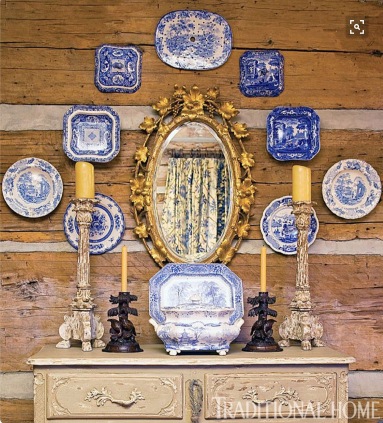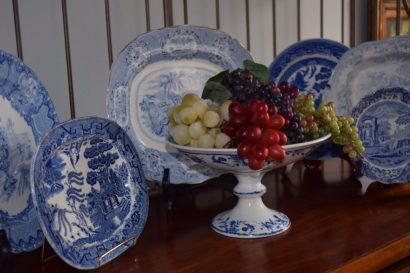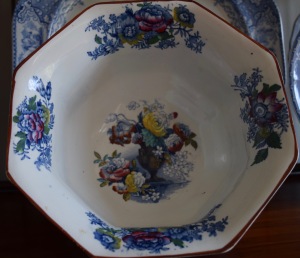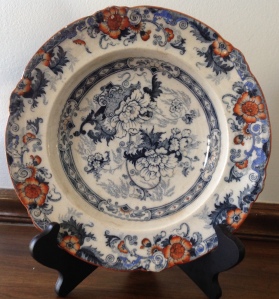
My blue & white transferware collection started accidentally.
Back in the decorating dark ages, before Pinterest, Houzz, Instagram, etc., I studied design magazines in search of inspiration and ideas. When stacks of magazines threatened to overwhelm the various baskets, shelves and cabinets where I stuffed them, I would page thru each issue, tearing out favorite and/or appealing photos and drop them into a file. (Sometimes I wasn’t even sure why I liked them, but I saved a lot of pictures.)
Many photos were like the ones at left and below. Eventually, I realized that often the rooms I admired featured blue and white transferware and I decided then that acquiring some of these accent pieces could go a long way to getting the “look” I was after. So, when I saw affordable pieces at antique markets and second hand shops, I snapped up what I could.

What are we talking about here?
Transferware describes a type of pottery, most often plates, cups, vases, serving pieces and the like, decorated by transferring a detailed engraving from an inked copper plate to the blank pottery before firing. Although initially I was attracted to these pieces because of the blue and white color, I have come to appreciate the technique behind transferware. (Can you imagine the skill required to create the detailed engraving and then transfer it?) Lidy at The French Garden House offered a more expert explanation of this here. (The photos she includes of her collection are wonderful, and you can check out the pieces she has for sale on her website if ayou click on the “Shop” tab.)
The pieces of red and white transferware below illustrate the detail that went into many of the designs (I especially like when designs are repeated inside a piece as on the left). If you look closely at the piece on the right you can see that the design was not perfectly applied; it’s crooked on the bottom. I suppose it makes it a little less valuable, but I think it also reveals the hand-work that went into this piece.


Most of the pieces I have collected are from England, but others are French and some are American. I think there are just greater quantities of English transferware in the marketplace. Many of these pieces were manufactured for the 19th Century’s growing middle class. Bigger, more elaborate pieces and designs were created for the higher-end market. (There’s always a higher-end market!)

It did not take long for my transferware collection to reach beyond blue and white to encompass a number of red and white and brown and white pieces as well. I’m not sure why a particular piece “calls my name.” I’m often attracted to a plate or platter by the detailed border of the design or if a piece is shaped by scallops or fluting. These days I am searching out shapes beyond plates and platters. The compote in the image above is a new find. Some pieces are antique and others are reproductions. I guess I’m an equal opportunity collector!

These sugar bowls are a great example of my haphazard collecting. They share a common shape. Although the red one is round it also has a fluted base and the red and blue versions both have interesting lids. Sadly, the brown piece is missing its lid, but I really admire the crisp detail in its design. It’s much sharper than the other pieces. And look at the upswept handles on each piece! I’m crazy abut these details!
Sometimes transferware designs use more than one color. I found this fairly large bowl on a cold, sometimes rainy day at an end-of-season antique market. It’s less than perfect (you can see where it’s chipped). However, I loved the rich colors and the floral pattern which continues inside the bowl. I snapped it up for less than $50 (it pays to shop in the rain!) and it has been the star of the china cabinet for several years since. Or at least that’s the role it assumes when it’s not holding fruit or a holiday centerpiece.


 This blue and orange plate is a more recent find. It’s proof that blue and white transferware rocks the orange/rust shades of autumn. Unfortunately, it has no identifying mark on the back, but it shows significant age.
This blue and orange plate is a more recent find. It’s proof that blue and white transferware rocks the orange/rust shades of autumn. Unfortunately, it has no identifying mark on the back, but it shows significant age.
My attachment to transferware drove some of the design decisions I made during our kitchen renovation a few years ago. I insisted on the “mantle” over the stove so I could show off a few special antique pieces. And I chose the green tile backsplash because it looked so good with the transferware. (Yes, I shopped for tile with a small plate in my pocket!)

I’ve been thinking about what drives this particular collection for me. It started with color and certainly that continues to play a role, but I also love the process behind these pieces and the fact that some of these designs are so well-loved, they are often revived in contemporary versions of their antique forebears. It’s also clear that some of my pieces are well-used, and I like to think that someone long ago set their table with the same plate or platter.

This is another favorite plate. It has the kind of details I really like: a fluted edge and that remarkable light and dark pattern that repeats on the lip of the plate. Lately I’ve been trying to pay more attention to these design nuances when I find something new to add to my collection.
I should add a disclaimer here that not everything in my collection is vintage or antique. I do have a number of reproductions, including all of the ginger jars that I display with some of the larger platters.
 After I snapped this photo of a number of pieces I show off in the living room in my grandmother’s china cabinet, I realized that whether I consciously intended to or not, I continue to channel those photos I’ve saved. Compare this image to the one from Nell Hills at the opening of this post!
After I snapped this photo of a number of pieces I show off in the living room in my grandmother’s china cabinet, I realized that whether I consciously intended to or not, I continue to channel those photos I’ve saved. Compare this image to the one from Nell Hills at the opening of this post!
This collection is not especially valuable. I’ve acquired the pieces in a haphazard, whatever-is-affordable way. And, clearly, it has morphed considerably from my first purely decorative purpose. But like any collection — cookbooks, garden plants, quilts — it has been a joy to acquire and I can’t imagine our home without it!
See you next time!

I love the colors and the traditional designs of transferware, but I never knew how it was made. Thanks for explaining.
LikeLike
like you, it was “the look” that initially drew me. But the more I acquired, the more I realized I needed to learn something about the pieces. And it was only after I had a number of items together that I began to see the differences in design themes, like floral or oriental.
LikeLike
Love seeing pieces of your collection!
LikeLike